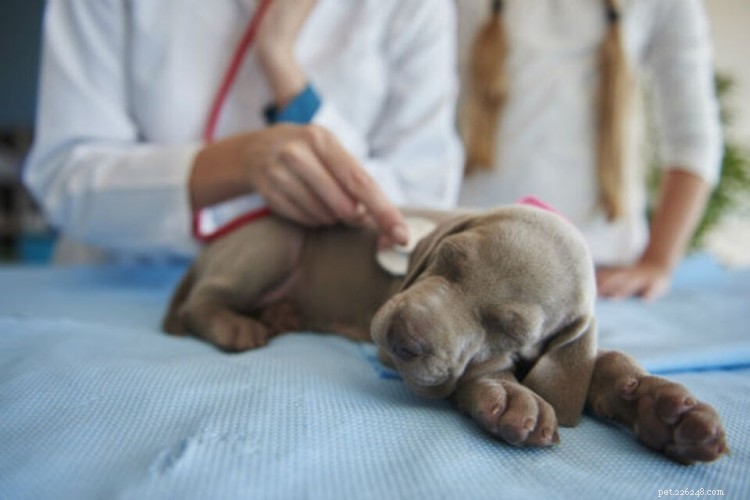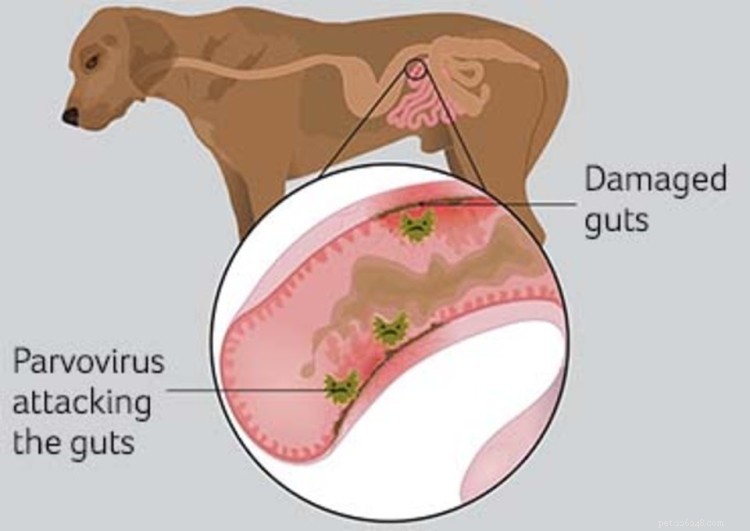Valpar är mycket mottagliga för många sjukdomar eftersom deras immunförsvar inte är fullt utvecklat. Ett exempel är parvo, ett otäckt virus som angriper tarmarna och orsakar svår diarré, kräkningar och uttorkning. Parvo är mycket smittsamt och särskilt farligt för ovaccinerade valpar yngre än sex månader.
Den här guiden kommer att berätta allt du behöver veta om parvo hos valpar, inklusive de vanligaste parvosymtomen och de steg du kan vidta för att skydda ditt husdjur från denna potentiellt dödliga sjukdom.
Proffstips :Djurförsäkring täcker parvo om din valp har fått alla sina rutinvaccinationer. Det är bäst att anmäla sig innan din valp utvecklar hälsokomplikationer, annars kanske tillståndet inte täcks.
Innehållsförteckning:
Parvovirus från hund, känt som parvo eller CPV, är ett mycket smittsamt virus som angriper mag-tarmsystemet (GI) hos valpar och unga hundar . Viruset kan lätt spridas genom kontakt med en infekterad valp eller genom indirekt kontakt med ett förorenat föremål, såsom vattenskålar, leksaker och till och med människors händer.
Viruset angriper magen och tunntarmen, förstör celler, försämrar upptaget av näringsämnen och stör tarmbarriären. Hos valpar kan parvo också påverka den lymfopoetiska vävnaden och benmärgen. I vissa fall kan parvovirus infektera hjärtmuskeln (hjärt-CPV ), vilket vanligtvis är dödligt men mycket mindre vanligt.
Viruset är köld- och värmebeständigt med förmågan att överleva upp till ett år utomhus och fem år inomhus. CPV är resistent mot alkohol, rengöringsmedel och många desinfektionsmedel, varför det kan vara svårt att innehålla.
 (Bildkälla:American Kennel Club)
(Bildkälla:American Kennel Club)
Valpar utsätts för parvo när de luktar, slickar eller rör vid infekterad avföring - vilket kan vara särskilt problematiskt för unga hundar som utforskar världen med sina sinnen. Parvoöverföring hos valpar kan också inträffa när de kommer i kontakt med ett förorenat föremål eller en person i sin miljö. Även skor som trampar på infekterad avföring kan föra in viruset i huset, där det kan leva i marken i upp till ett år.
Även om alla hundar är i riskzonen är parvo vanligast hos ovaccinerade valpar mellan sex och 12 månader gamla . Lyckligtvis behåller ungar yngre än sex veckor fortfarande en del av sin mammas antikroppar, förutsatt att hon fick hela vaccinet. Husdjursföräldrar bör notera att vissa raser löper högre risk att bli infekterade med parvo, nämligen:
Ta extra försiktighetsåtgärder för att skydda mot parvo hos valpar som tillhör dessa raser.
Valpar med parvo börjar sprida viruset inom fyra till fem dagar efter exponering, vanligtvis innan kliniska tecken utvecklas. När sjukdomen börjar, inkluderar några av de vanligaste parvosymtomen hos valpar:
Om du märker någon av de röda flaggorna ovan, kontakta din veterinär ASAP . Se till att informera dem i förväg om valpens tillstånd och dina bekymmer, så att personalen kan vidta nödvändiga karantänsåtgärder för att förhindra ytterligare överföring.
Först kommer din veterinär att ta blodprov för att bekräfta att din valp har parvo. The vet might also run an ELISA test to look for CPV antigens in the feces.
Parvo weakens a puppy’s immune system, lowers the white blood cell count, and damages the intestinal wall, reducing the pet’s ability to combat secondary bacterial infections. The mortality rate in canines that receive no treatment is over 90%, compared to 10-25% in those that are hospitalized . Therefore, hospitalization is strongly recommended for puppies with parvo symptoms.
Hospitalizing a puppy for parvo treatment costs about $2,000 to $3,000 just for the first day . Some patients might have to stay in the hospital for three to five days depending on the severity of the case (very sick puppies might stay in the hospital for up to ten days if they require intensive care).
Puppies infected with parvo will be placed in an isolation ward to prevent transmission between doctors, nurses, or other animals in the hospital. They will also receive IV fluids, pain medication, anti-nausea medication, and antibiotics. A nasogastric tube might also be necessary in order to provide nutritional support.
If hospitalization is not possible due to financial reasons, there’s an outpatient protocol that includes learning how to administer anti-nausea medication and IV fluids under the puppy’s skin, administering oral medications, and checking their temperature. Frequent vet visits will be necessary to check blood sugar levels and electrolytes on a daily basis. This option may not be possible depending on the severity of the infection.
Your vet will recommend an appropriate treatment for your puppy’s individual case and let you know which precautionary measures you should take in order to protect any other dogs and puppies in your home.
Pro tip :Treatment for parvo can require 10 days of hospitalization. Without pet insurance that could cost hundreds or even thousands of dollars. Luckily, routine puppy vaccinations, which can be covered through pet insurance plans, include vaccinations for parvo. These vaccinations require multiple shots and vet visits, so pet parents should take some time to compare pet insurance plans and find a policy that will cover this routine care.
 (Image source:PDSA)
(Image source:PDSA)
Most parvo patients recover if aggressive treatment is used and therapy is started before severe dehydration and septicemia occur. Most puppies that make it through the first three to four days will recover completely. Recovery usually takes about a week, but it depends on the severity of the case.
Some breeds, such as the Doberman Pinscher, English Springer Spaniel, and Rottweiler, have a significantly higher fatality rate than other dog breeds.
Puppies continue to shed the parvovirus for up to ten days after recovery, so make sure to keep any animals recovering from the virus away from unvaccinated or partially vaccinated dogs.
Parvovirus is preventable through vaccination . Puppies shoulbe be vaccinated against the virus every two to four weeks starting at six to eight weeks old, up until they are at least 16 weeks old. The last shot at 16 weeks is required for coonfidence in lasting immunity. Until the round of vaccines is complete, they should be kept away from public areas where other unvaccinated dogs could be, such as dog parks.
Ensure that all dogs in your home are vaccinated. It’s very important that female dogs receive a full series of parvo vaccines, as the young puppies depend on the dam’s antibodies in their first weeks of life. Pregnant females can also be boosted with a parvovirus vaccine 2-4 weeks before giving birth in order to transfer higher levels of antibodies to the puppies. Your vet will help you make the final decision about a vaccination schedule that best fits your pet.
You should also be extra careful when socializing your pet. Until puppies have received all of their vaccines, they should be allowed to come into contact with unvaccinated dogs. Avoid dog parks as well as other places where canines gather and try to socialize your puppy in less public environments such as your home.
The stability of the parvovirus in the environment makes it very important to properly clean and disinfect contaminated kennels, crates, bedding, and other areas where infected canines are kept in order to keep the spread under control. A solution of 1 gallon of water and 1/2 cup of chlorine bleach will disinfect water and food bowls, as well as other contaminated items. Your vet can provide specific guidance on cleaning and disinfecting agents for your home.